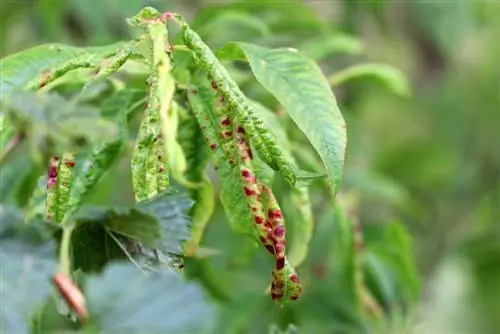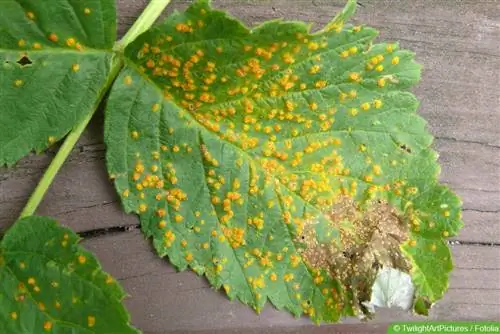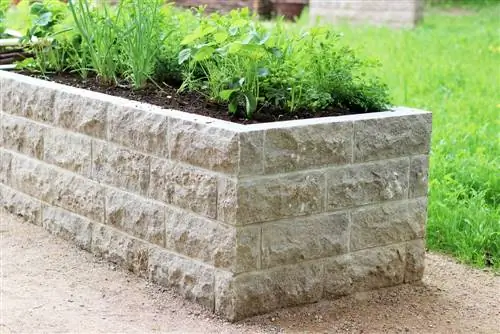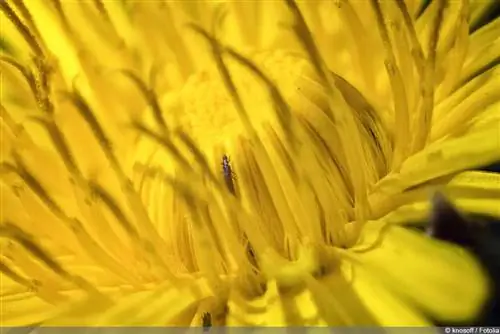- Author admin [email protected].
- Public 2023-12-17 03:39.
- Last modified 2025-06-01 06:48.
The boxwood moths or Cydalima perspectalis, as they are also called, appear harmless at first glance and even pretty in a simple way. However, their caterpillars and the butterflies have gained a reputation as voracious pests. If an infestation is not recognized early and the insects are not controlled, they can cause the boxwood trees to die. There are even known cases of damage to other plants. Therefore, quick and targeted action is required as soon as the borers have been identified.
Dissemination
The boxwood moths are small butterflies that are mainly active at night. They are native to East Asia, but have been seen more and more frequently in Europe since 2006 and have already caused the death of entire boxwood collections.
It is assumed that the butterflies came to Europe via cargo ships and plant deliveries and from there spread through garden centers, nurseries and gardens. The distribution benefits from a preference for Cydalima perspectalis - as the box tree moths are known in technical language. The females prefer to lay their eggs on box trees that have not yet been infected.
The pests do not only move on when a plant is already damaged and the food source is lost.
Appearance of the moths
As mentioned, the boxwood moths are rather inconspicuous. The adult butterflies have a wingspan of four to five centimeters. The wings are usually silky white and edged with brown to black. However, specimens have also been spotted that have brown to black wings with white spots. This can make recognition more difficult.

In addition, the butterflies are active at night and when temperatures are constantly above 7°C, so they are usually not immediately noticeable even in a garden that is maintained daily. What makes matters worse is that the adult insects prefer to stay on the lower sides of the boxwood leaves. However, it is not the butterflies themselves that cause damage to the boxwoods.
Eggs
The female boxwood moths lay their eggs on the underside of the leaves of a boxwood tree. They prefer plants that have not yet been infected. 150 eggs are possible per clutch.
The eggs are pale yellow in color and have a flat lens shape. Initially they are found primarily on the lower sections of the plant and here on the outer leaves. With regular and precise checks, they can be noticed relatively quickly due to the slight difference in color. However, they are still difficult to find, especially on larger boxwoods or on forms that have dense foliage just above the ground.
In addition, they can only be found for about three days, because then the caterpillars of the box tree moth hatch out of them.
Caterpillars
As soon as the eggs hatch, the larvae of the box tree borer begin to damage the plant. They first eat the leaves. Later, the bark and whole shoots will also be on your menu - for several weeks.
Until the caterpillars with green and yellowish longitudinal stripes develop into butterflies, they go through seven larval stages. During this time they have an extreme appetite. This is understandable because the caterpillars can reach a length of up to five centimeters and need energy reserves for pupation and the subsequent metamorphosis.
The stage of life as a caterpillar can last three to ten weeks for boxwood moths. The duration depends on the temperature. At around 15 °C, the transformation from egg to butterfly takes over two months. At 20 °C, however, not even a month. During pupation, the caterpillars entrench themselves in the boxwood. The threads are reminiscent of spider webs, but are much more densely woven.
Wintering
Cydalima perspectalis or, more precisely, its caterpillars overwinter directly on the plants on which they feed. They pupate and entangle themselves in the leaves. Depending on the size, the cocoons can be very well or barely visible.
With the onset of spring and as soon as the thermometer consistently climbs above seven degrees, the development will continue.
Active phase
The butterflies and their caterpillars are active depending on the temperature, although in our latitudes these are usually sufficiently high for the insects from early spring to autumn.
Damage
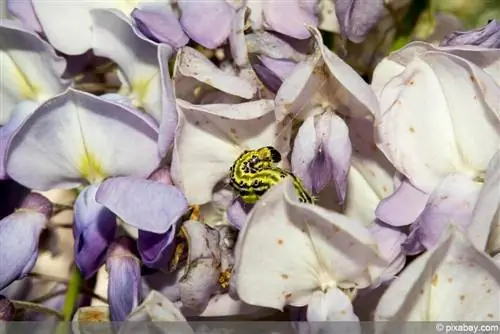
As a result of the caterpillars' feeding, the outer leaves of the lower areas of the box trees initially turn beige-brown. As the infestation progresses, the damage spreads internally and upwards. This does not necessarily cause the plant to die. The longer the boxwood borer is present on the plants, the greater the risk.
Prevention through controls
The most important form of prevention is precise visual inspections when purchasing and existing boxwoods. Common boxwood and small-leaved boxwood in particular should be checked thoroughly, as these are particularly frequently attacked. The signs of such an infestation are:
- beige, brownish or yellowish colored leaves
- pale yellow bumps on the undersides of the leaves (eggs)
- Cobwebs or threads
- feeding marks
- Cocoons
If you have these warning signals, you should not make a purchase and the seller should also be informed. With your own boxwood trees in the garden, cutting the affected areas and destroying the clippings can prevent a major infestation and save the plants.
Under no circumstances should the removed leaves end up in the compost or in the trash. The pests could then still spread. If possible, the cuttings can be burned or doused with boiling water to kill the insects. Otherwise it should be disposed of in a completely airtight container with household waste.
Boxwood borer traps
In order to specifically combat boxwood moths, it must first be known whether they are really East Asian butterflies. Since the caterpillars do not differ visually from other species, identification can be difficult. Even with the eggs, it is not possible for laypeople to clearly identify them.
The boxwood moth traps are a practical tool here. They usually consist of a sturdy housing containing pheromones and a glue trap. The male adult butterflies are attracted to it and get stuck in the trap. This results in several advantages:
- the infestation is being controlled
- the butterflies can be identified more easily
- the males are no longer available for reproduction
- The boxwood borer traps can be used for an entire garden season
Fighting boxwood borers with natural enemies
When the boxwood borers were introduced to Europe, they had an easy time of it. Boxwoods can also be found in abundance in private gardens, on balconies and terraces. The food supply was correspondingly high. The lack of natural enemies also contributed to the unhindered spread.
Birds ate the caterpillars, but regurgitated them straight back out. Other beneficial insects showed no interest at all.
Fortunately, the situation has changed. Birds and wasps in particular have developed a taste for boxwood moth caterpillars, use them as a source of protein and thereby combat them effectively. In order for natural enemies to take over the removal of the pest, they should be welcome in the garden and “pointed out” to the infestation.
Use birds as natural predators
The following measures are useful for attracting and settling birds:
- offer several nesting boxes and nesting material
- Feeding birds on colder days and in winter
- Protect trees, nesting and feeding places from cats and other animals
Wasps as natural enemies of the boxwood borer
Wasps have a dubious reputation, can be annoying and even dangerous if you have allergies. However, they are certainly useful helpers in combating pests and, according to recent observations, are also effective against box tree moth caterpillars. The wasps break them down into smaller pieces and fly them back to their nest.
This means that the removal is not quite as efficient in terms of quantity as with the birds. However, the wasps can penetrate deeper into the boxwood more easily.
Again, the presence of wasps can help combat them. It makes sense here:
- Nests not to be removed
- Apply attractants such as fruit juice, sugar water or vinegar near the box trees
- collect a few caterpillars and cut them up and place them on and under the boxwood
Parasitic wasps as natural enemies
The effect of parasitic wasps on East Asian butterflies has not yet been proven, but convincing results have already been achieved with the beneficial insects on other butterflies. Since the parasitic wasps are inexpensive and also target other pests without becoming a nuisance themselves, it's worth the try.
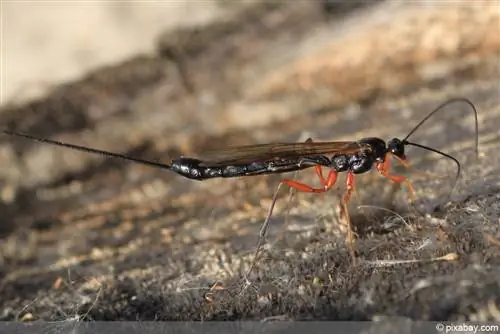
Parasitic wasp eggs are commercially available mounted on cards. These are hung or placed in the affected box. After hatching, the beneficial insects eat into the caterpillars' bodies and kill them from the inside.
Tip:
Parasitic wasps can neither fly nor sting and are therefore the ideal choice for those with wasp allergies. They can also be used in a targeted manner and are just as suitable for the garden as for boxwood on the balcony or terrace.
Home remedies to combat it
Cydalima perspectalis should also be able to be driven away or combated using simple home remedies. The effect of this has not been proven, but practical tests have already shown some good results.
Collect
Collecting the pests by hand is simple but laborious. In addition, this method only makes sense at the beginning of an infestation, when the borer larvae are still sitting on the outer areas.
Compressed air against borer
Compressed air or compressed air can literally “blow” the caterpillars out of box. This makes sense, for example, if there are already many larvae inside - but natural predators cannot get to them due to the dense growth.
Tip:
Always spray from top to bottom and, if possible, cover the area with a tarpaulin to make it easier to collect the caterpillars afterwards.
dishwashing liquid
The following home remedy or spray is inexpensive and simple:
- Cover the soil with a tarpaulin.
- Mix a few drops of dishwashing liquid in water and spray the box with this solution.
- Leave for ten to 20 minutes.
- Rinse the leaves thoroughly with a hard jet of water.
- Collect and destroy fallen caterpillars.
The application should best be repeated twice a week.
Oil and vinegar against boxwood moth
Similar to dishwashing liquid, this method involves mixing equal parts vinegar, oil and water together and using it to spray the boxwood. Experience has shown that some caterpillars can fall within just a few minutes if the solution is also sprayed in lower areas.
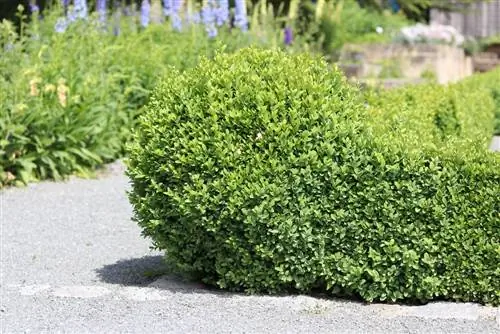
Then you rinse with clear water and as hard a jet as possible to remove the residues, the caterpillars are collected and destroyed. To protect the substrate and make collection easier, a tarpaulin should be laid out.
Fight boxwood moths with high water pressure
Instead of using solutions, the boxwood can also be freed from the Cydalima perspectalis caterpillars directly with a hard jet of water. The garden hose can be sufficient for this, but a high-pressure cleaner is ideal, although the pressure should of course be adjusted so that the plant does not suffer any additional damage.
The application should best be repeated daily in order to remove as many of the pests as possible. Again, a pad can be helpful to make the subsequent collection and destruction of the larvae easier.
Biological sprays
Biological sprays with Bacillus thuringiensis and azadirachtin have proven successful in combating the box tree borer. Bacillus thuringiensis are bacteria that are eaten by butterfly larvae and cause them to die. Sprays with this are particularly effective in dry, warm phases when the caterpillars eat a lot and the solution is not washed off the leaves by rain. Applications should be repeated weekly or every two weeks.
Azadirachtin is a substance from neem oil that causes the caterpillars to die when they come into direct contact with them. Treatment with products containing azadirachtin should be repeated several times in the event of an infestation in order to eliminate any larvae that hatch afterwards
Tip:
A pressure sprayer should be used to apply the spray agents so that the inner areas of the boxwoods can also be wetted with the solutions.
Conclusion
Boxwood moths can spread very quickly due to their numerous eggs and their ability to lay them on boxwood trees that have not yet been infected and can cause major damage in a very short time, especially in warm weather. Early detection and targeted control of pests can therefore mean the difference between a minor nuisance and a widespread nuisance. In addition to - ideally - daily checks, it is recommended to combine the various means and methods with one another as far as possible.


